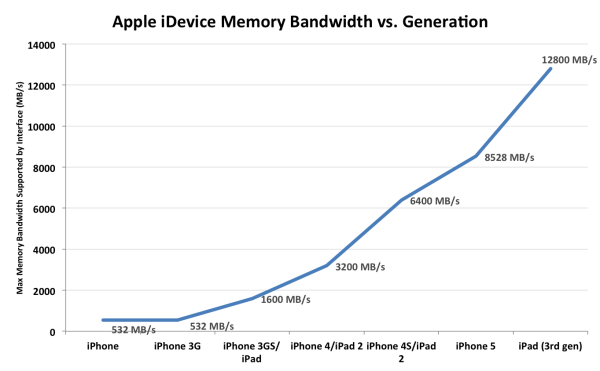iPhone 5 Memory Size and Speed Revealed: 1GB LPDDR2-1066
by Anand Lal Shimpi & Brian Klug on September 15, 2012 8:53 PM EST- Posted in
- Smartphones
- Apple
- Mobile
- SoCs
- iPhone 5
Quick analysis of the A6 SoC photos from the iPhone 5 launch event tells us all we need to know about the memory interface, speed and bandwidth of the new platform. As always, the A6 features a PoP stack combining the SoC itself and its DRAM. The package-stacked DRAM helps save space, which comes at a premium inside a device as small as a smartphone. PoP stacks are quite common in all modern smartphones.
Apple thankfully didn't obscure the details of its A6 slide at the launch event, which gave us a Samsung part number: K3PE7E700F-XGC2. Through crafty navigation of Samsung's product guide, Brian Klug got us the details. The K3P tells us we're looking at a dual-channel LPDDR2 package with 32-bit channels. The E7E7 gives us the density of each of the two DRAM die (512MB per die, 1GB total). The final two characters in the part number give us the cycle time/data rate, which in this case is 1066MHz.
Plug all of that into our memory bandwidth scaling chart and you get this:
Roughly 33% more peak memory bandwidth than the iPhone 4S, which can definitely help feed the faster GPU and drive the higher resolution display. Many vendors have been shipping LPDDR2-1066 so there's nothing too surprising here. There's understandably less bandwidth than in the 3rd gen iPad of course as the display/GPU requirements aren't nearly as high.
There's more than just memory clocks that will impact memory bandwidth here. It's unclear whether the A6 improves the memory controller Apple deployed in the A5. ARM architectures (especially in the A9 generation) have typically struggled getting good memory bandwidth efficiency. We'll have to see what happens with the A6.











24 Comments
View All Comments
Luke.Hi - Sunday, September 16, 2012 - link
Hi guys! You table shows "MB/s" - does that mean megaBIT or megaBYTE per second?nfineon - Sunday, September 16, 2012 - link
Capital MB normally means megaBYTES whereas Mb = megaBiTSDeath666Angel - Sunday, September 16, 2012 - link
Big "B" stands for byte, small "b" stands for bit.tipoo - Sunday, September 16, 2012 - link
The Pentium 4 HT Extreme Edition had memory bandwidth between 6400 MB/s-8512 MB/s depending on the model, I always find it interesting to compare how far along these mobile SoCs have come.danielfranklin - Sunday, September 16, 2012 - link
Indeed interesting stuff, but its important to remember the desktop's of those days most often had dedicated graphics with its own memory bandwidth.I was picturing my Celeron 300A with a 64bit 100mhz mem bus when i looked at the chart, wasnt much was it...
ltcommanderdata - Sunday, September 16, 2012 - link
http://www.macrumors.com/2012/09/16/iphone-5-bench...Geekbench results are up for the iPhone 5. It reports 1GHz dual core with 1MB L2 cache. The Geekbench score works out to be 2.5x faster than the iPhone 4S.
http://browser.primatelabs.com/geekbench2/1030202
http://browser.primatelabs.com/geekbench2/1028498
The biggest improvement turns out to be in memory bandwidth with a 3.2x increase from iPhone 4S to iPhone despite only a 33% theoretical increase going from LPDDR2-800 to LPDDR2-1066. I guess Apple has redesigned the memory controller for more bandwidth efficiency as Anand mentioned was needed.
igotsnomoney - Sunday, September 16, 2012 - link
Going around the internet when i fount iphone5,2 in the geekbench browser. Apple really did mean 2x performanceThe A6 is one powerful SoC
http://browser.primatelabs.com/geekbench2/1030202
BSMonitor - Monday, September 17, 2012 - link
But I love how we get all excited for performance from 1998 in these tiny All-in-One PCs!!I want the Ivy Bridge smart phone I can dock to replace my work PC. ;-)
rocky12345 - Monday, September 17, 2012 - link
HelloI like the site a lot but can we please stop with all the iphone 5 this & that stuff. I mean come on we all know there will be a review of this new phone from Apple so if we could please leave all of the tiny liittle articals for the big & up & coming review that would be great. I have never seen so much coverage of a simple little cell phone before on one site. please just take all the speculation & facts & put it into one review.
This is a great site been coming here since day one when it opened up but if you are going to give Apple so much site time for what they call a new device then all products should get the same attention. I am not saying the site is biased towards one company,we all know this is a very open minded site 99.99% of the time.
Thank You
Long Time AnandTech Reader.
A5 - Monday, September 17, 2012 - link
These articles are pretty much the point of the Pipeline section. No one is making you read them, but Anand has to pay the bills and these iPhone articles drive a ton of traffic.